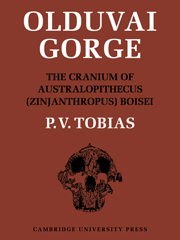Book contents
- Frontmatter
- Contents
- List of text-figures
- List of plates
- List of tables
- Introductory Note
- Foreword
- Editor's Note
- Acknowledgements
- I Introduction
- II Preservation and reconstruction of the cranium
- III The cranial vault
- IV The basis cranii externa
- V Certain critical angles and indices of the cranium
- VI The interior of the calvaria
- VII The thickness of the cranial bones
- VIII The endocranial cast of Zinjanthropus
- IX Metrical characters of the calvaria as a whole
- X The structure of the face
- XI The pneumatisation of the Zinjanthropus cranium
- XII The dental arcade and the palate
- XIII The pattern of dental attrition and occlusion, with comments on enamel hypoplasia
- XIV The size of individual teeth, absolute and relative
- XV The size of the dentition as a whole
- XVI The crown shape index of the teeth
- XVII The morphology of the teeth
- XVIII Summary of cranial and dental features of Zinjanthropus
- XIX The taxonomic status of Zinjanthropus and of the australopithecines in general
- XX The cultural and phylogenetic status of Australopithecus boisei and of the australopithecines in general
- References
- Index of persons
- Index of subjects
- Plate section
XVII - The morphology of the teeth
Published online by Cambridge University Press: 05 November 2011
- Frontmatter
- Contents
- List of text-figures
- List of plates
- List of tables
- Introductory Note
- Foreword
- Editor's Note
- Acknowledgements
- I Introduction
- II Preservation and reconstruction of the cranium
- III The cranial vault
- IV The basis cranii externa
- V Certain critical angles and indices of the cranium
- VI The interior of the calvaria
- VII The thickness of the cranial bones
- VIII The endocranial cast of Zinjanthropus
- IX Metrical characters of the calvaria as a whole
- X The structure of the face
- XI The pneumatisation of the Zinjanthropus cranium
- XII The dental arcade and the palate
- XIII The pattern of dental attrition and occlusion, with comments on enamel hypoplasia
- XIV The size of individual teeth, absolute and relative
- XV The size of the dentition as a whole
- XVI The crown shape index of the teeth
- XVII The morphology of the teeth
- XVIII Summary of cranial and dental features of Zinjanthropus
- XIX The taxonomic status of Zinjanthropus and of the australopithecines in general
- XX The cultural and phylogenetic status of Australopithecus boisei and of the australopithecines in general
- References
- Index of persons
- Index of subjects
- Plate section
Summary
The maxillary incisors
The central incisors
Both I1's are present and damaged, most of the enamel being lost from the mesial and distal faces, as well as from the distal part of the labial face of the right I1. The teeth are worn, the right more than the left, so that the height from the cervical line to the incisal edge is 8·1 mm. on the left and 7·4 mm. on the right. Thus the morphological features on only about the cervical two-thirds of the crown remain for examination.
The lingual surface is slightly shovel-shaped; the bases of the faintly raised, mesial and distal marginal ridges flank the lingual fossa. A small pit lies near the base of each marginal ridge, close to the mesial and the distal margins of the tooth respectively. Between the two marginal ridges are the cervical parts of two lingual depressions (‘mesiale und distale Vertikalgrube’ of Remane, 1960), separated in the[midst]of the lingual fossa by a slight cervicoincisal elevation (‘mittleren Hauptleiste’).
At the base of this cervico-incisal elevation, that is, on the upper part of the lingual face, is a rounded protuberance: we shall follow Robinson (1956, p. 23) in calling this the gingival eminence, and it corresponds to the ‘basale Verdickung der mittleren Hauptleiste’ which Remane (1960, p. 782) synonymises with tuberculum linguale or tuberculum dentale. The prominence is named ‘dental tubercle’ by Sicher (1949, p. 210).
- Type
- Chapter
- Information
- Olduvai Gorge , pp. 175 - 192Publisher: Cambridge University PressPrint publication year: 1967



